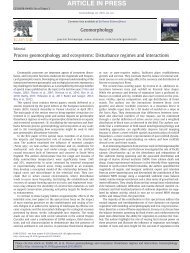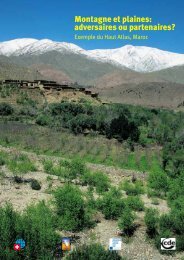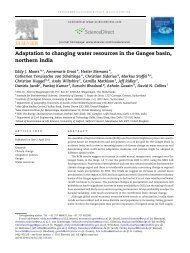(2010): Debris-flow activity along a torrent in - Dendrolab.ch
(2010): Debris-flow activity along a torrent in - Dendrolab.ch
(2010): Debris-flow activity along a torrent in - Dendrolab.ch
Create successful ePaper yourself
Turn your PDF publications into a flip-book with our unique Google optimized e-Paper software.
Author's personal copy<br />
Dendro<strong>ch</strong>ronologia 28 (<strong>2010</strong>) 215–223<br />
ORIGINAL ARTICLE<br />
<strong>Debris</strong>-<strong>flow</strong> <strong>activity</strong> <strong>along</strong> a <strong>torrent</strong> <strong>in</strong> the Swiss Alps: M<strong>in</strong>imum<br />
frequency of events and implications for forest dynamics<br />
Ann<strong>in</strong>a Sorg a , Harald Bugmann a , Mi<strong>ch</strong>elle Bolls<strong>ch</strong>weiler b,c , Markus Stoffel b,c,∗<br />
a Forest Ecology, Institute of Terrestrial Ecosystems, Department of Environmental Sciences, Swiss Federal Institute of Te<strong>ch</strong>nology of Zuri<strong>ch</strong>,<br />
CH-8092 Züri<strong>ch</strong>, Switzerland<br />
b Laboratory of Dendrogeomorphology, Institute for Geological Sciences, University of Berne, CH-3012 Berne, Switzerland 1<br />
c Climatic Change and Climate Impacts Group (C 3 i), Institute for Environmental Sciences, University of Geneva, CH-1227 Carouge-Geneva,<br />
Switzerland<br />
Received 12 December 2008; accepted 9 November 2009<br />
Abstract<br />
This study reports on a tree-r<strong>in</strong>g-based reconstruction of geomorphic <strong>activity</strong> and illustrates impacts of su<strong>ch</strong> processes on<br />
tree germ<strong>in</strong>ation <strong>along</strong> a debris-<strong>flow</strong> <strong>torrent</strong> <strong>in</strong> the Swiss Alps. Analysis <strong>in</strong>cluded the identification of growth disturbances and<br />
the assessment of germ<strong>in</strong>ation dates for 28 trees <strong>along</strong> the <strong>ch</strong>annel of the Geisstriftba<strong>ch</strong> <strong>torrent</strong> (Valais, Swiss Alps). Provided<br />
that recoloniz<strong>in</strong>g trees <strong>in</strong>dicate the m<strong>in</strong>imum time elapsed s<strong>in</strong>ce the last deposition, germ<strong>in</strong>ation dates suggest that a devastat<strong>in</strong>g<br />
debris-<strong>flow</strong> event <strong>in</strong> the 1880s had cleared the surface and scoured the currently active <strong>ch</strong>annel. This <strong>in</strong>terpretation is supported<br />
by two topographic maps show<strong>in</strong>g a dislocation of the <strong>ch</strong>annel. Analyz<strong>in</strong>g the age structure of trees <strong>along</strong> the <strong>ch</strong>annel <strong>in</strong> more<br />
detail, we observe higher tree ages with <strong>in</strong>creas<strong>in</strong>g distance from the cone apex. In addition, dendrogeomorphic methods allowed<br />
for the reconstruction of 13 debris-<strong>flow</strong> events between AD 1913 and 2006. In comb<strong>in</strong>ation with geomorphic mapp<strong>in</strong>g, the<br />
spatial distribution of trees affected by <strong>in</strong>dividual events was assessed and a m<strong>in</strong>imum frequency of previous debris-<strong>flow</strong> events<br />
reconstructed. Although the present study was based on a limited set of tree-r<strong>in</strong>g records, it illustrates that tree-r<strong>in</strong>g analysis <strong>in</strong><br />
comb<strong>in</strong>ation with cartographic methods holds mu<strong>ch</strong> promise for dat<strong>in</strong>g m<strong>in</strong>imum ages of surfaces cleared by destructive events<br />
as well as for determ<strong>in</strong><strong>in</strong>g the spatio-temporal impacts of past debris-<strong>flow</strong> <strong>activity</strong>.<br />
© <strong>2010</strong> Istituto Italiano di Dendrocronologia. Published by Elsevier GmbH. All rights reserved.<br />
Keywords: Dendrogeomorphology; Mounta<strong>in</strong> forest; Germ<strong>in</strong>ation; Disturbance events; Larix decidua Mill.; Picea abies (L.) Karst.<br />
Introduction<br />
Mounta<strong>in</strong> forests provide many ecosystem goods and services<br />
worldwide (Huber et al., 2005), among others by<br />
∗ Correspond<strong>in</strong>g author at: Laboratory of Dendrogeomorphology, Institute<br />
for Geological Sciences, University of Berne, Baltzerstrasse 1+3, CH-3012<br />
Berne, Switzerland. Tel.: +41 31 631 87 73; fax: +41 31 631 48 43.<br />
E-mail address: markus.stoffel@dendrolab.<strong>ch</strong> (M. Stoffel).<br />
1 www.dendrolab.<strong>ch</strong>.<br />
protect<strong>in</strong>g human <strong>in</strong>frastructure from gravitational natural<br />
hazards su<strong>ch</strong> as snow avalan<strong>ch</strong>es and rockfall (Frehner et<br />
al., 2005). At the same time, mounta<strong>in</strong> forests are subject<br />
to harsh growth conditions, whi<strong>ch</strong> render them susceptible<br />
to natural and anthropogenic disturbances (Ott et al., 1997;<br />
Körner, 2003). For example, <strong>in</strong> many countries of the temperate<br />
zone, current mounta<strong>in</strong> forests carry the legacies of past<br />
over-exploitation, be<strong>in</strong>g <strong>ch</strong>aracterized by even-aged stands<br />
that are particularly susceptible to disturbance agents. An<br />
<strong>in</strong>-depth understand<strong>in</strong>g of future forest dynamics and the<br />
1125-7865/$ – see front matter © <strong>2010</strong> Istituto Italiano di Dendrocronologia. Published by Elsevier GmbH. All rights reserved.<br />
doi:10.1016/j.dendro.2009.11.002






